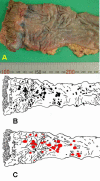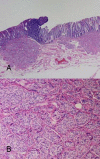Multiple rectal carcinoids with diffuse ganglioneuromatosis
- PMID: 17306015
- PMCID: PMC1805501
- DOI: 10.1186/1477-7819-5-19
Multiple rectal carcinoids with diffuse ganglioneuromatosis
Abstract
Background: Rectal carcinoids comprise only about 1% of all anorectal neoplasms. In addition, ganglioneuroma of the gastrointestinal tract is a rare tumor composed ganglion cells, nerve fibers, and supporting cells. Multiple carcinoid tumors with diffuse ganglioneuromatosis limited to the rectum are quite unusual.
Case presentation: A 69-year-old man was referred to us because of about 100 small submucosal rectal tumors. He underwent abdominoperineal resection. Pathology revealed carcinoid tumors for about 30 submucosal nodules and diffuse ganglioneuromotosis. To date (6 months later) he remains well with no recurrence.
Conclusion: Although the optimal treatment for the multiple rectal carcinoids remains to be clearly established, it is believed that not all patients with multiple rectal carcinoids (measuring less than 1 cm in diameter) need to have a radical operation. However, the treatment plan for each case should be individualized and a careful follow-up is mandatory.
Figures

 ).
).

References
-
- Winburn GB. Multiple rectal carcinoids: a case report. Am Surg. 1998;64:1200–1203. - PubMed
-
- Sumida T, Nagata S, Ougoshi H, Ishida Y, Kuwahara T, Tatsugami M, Tsuji K, Hidaka T, Tachiyama Y, Kaneko M, Hayashi Y. Multiple rectal carcinoid tumors treated by endoscopic mucosal resection-Report of a case. Gastroenterol Endosc. 2005;47:1419–1424. (in Japanease)
Publication types
MeSH terms
LinkOut - more resources
Full Text Sources
Medical

